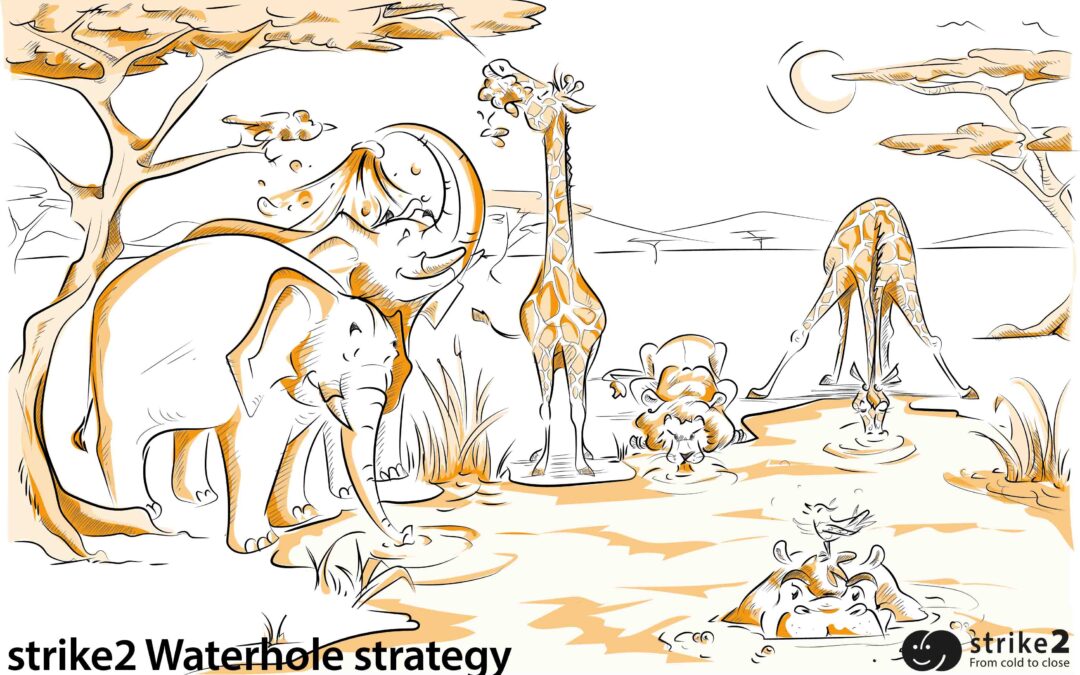How do you generate new prospects and/or existing customer sales?
Some companies do not actively generate leads and existing customer sales at all. They act according to the motto: ‘Customers will get in touch when they need something’ and engage in ‘aggressive waiting on the phone’.
Others use outbound measures such as cold calling or adverts. There are some challenges here:
- How do you reach the right customers?
- Who should you address?
- When is the right time?
- Who should you engage with more intensively?
And in times of digitalisation too:
- Changed purchasing behaviour
- Dwindling customer loyalty
- Transparency – the nearest competition is just a click away
- GDPR – How can you approach potential customers?
- Restricted customer access (Corona & Co. ) and popular events/trade fairs
As a result, outbound activities are rarely sufficiently successful and efficient today.
The strike2 waterhole strategy® describes a different, more contemporary approach. Paraphrased using the image of a photographer who has been commissioned to deliver pictures of elephants (in the wild). How can he realise this?
He can walk through desert, savannah, jungle and bush until he finds elephants. If he finds one, he can fulfil the order: He then has pictures of elephants.
Figuratively speaking, he has generated a new prospective customer. This describes the process of cold calling. You keep calling people until someone finally shows interest.
If this process is easy, motivating and successful for you, then by all means continue. However, I usually experience this differently with my customers in my consulting reality:
- I know very few salespeople who enjoy cold calling. Good service providers like and can do this and can also be integrated into the digital process if required.
- The efficiency of cold calling by salespeople is usually moderate. Too many calls are necessary to achieve significant results.
- Cold calls by your own sales team are usually difficult to scale.
- For most salespeople, there are much more motivating activities than cold calling.
And what happens to the next interested parties? To stay with the picture above, you have to start running again if you want to photograph elephants again or attract prospective customers. And you don’t know whether it will work every time!
A different approach – the strike2 Waterhole Strategy®
Back to the elephants. Even if you have been able to photograph elephants or attract prospective clients, the process starts all over again with new ‘picture assignments’ and you don’t know if you will be lucky enough to find elephants with an acceptable amount of time and resources each time.
How would you feel about ‘magically’ attracting elephants (customers) so that you can take pictures of elephants at any time? Then why don’t you build a ‘prospect/existing customer watering hole’? Build a ‘waterhole’ for your ideal prospects or ideal customers and make sure that the scent of the water spreads to the ‘elephants’.
Put up signs: ‘This way to delicious water. Elephants welcome!’
With this method, you will generate prospective customers who are actively looking for a solution to their challenges. They will be much more open to your offer and will probably be quicker to close the deal.
How does your waterhole build up?
Your presences together form your prospect waterhole. It is therefore made up of
Website- B
log ShopSocial media presence (Linkedin, YouTube and, if applicable, Facebook & Co.)Specialist portalsetc.
What is the water in your waterhole?
The water in your waterhole is content. Content that is relevant, helpful and/or entertaining for your ideal prospects or customers:
Website contentGuidesWhitepaperBlog articles- V
ideos Profile content and articles LinkedinApplication notesUser reportsetc.
How do you put up signs?
You spread the scent of the water in your waterhole to potential customers by placing content on your website. If you do this ‘search engine compliant’, the search engines will spread the ‘scent of your water’. You can place further signposts by placing parts of your content on other platforms such as Xing, Linkedin, specialist portals, guest posts in blogs, etc. and linking to your ‘watering hole’. The more content and links you add, the greater the appeal of your watering hole and the more fun and success you will have in sales.
What should you bear in mind when setting up?
You should not start ‘shovelling’ without a goal or a plan. Start by thinking about who you want to attract to your waterhole. Who is your ideal prospect, your ideal customer. As with animals at the waterhole, you should consider how the waterhole should be designed so that elephants feel comfortable there. Build up empathy for your ideal prospects. Create deep buyer persona profiles and define your ideal customer.
Profile dataPain points (in relation to your offer)Target states (in relation to your offer)Behavioural preferences (profit, efficiency, innovation, security, analyser, etc.)Decision structures and criteriaPossible obstaclesetc.
These profiles help you to organise your presence (waterhole) and content (water) in such a way that your desired customers come, like to stay and recommend you to others.
To stay in the picture:
They always have elephantsThe elephants stay freeWhere elephants come, giraffes may also feel at home
I came up with the idea of the waterhole strategy in 2011 while preparing for my book ‘The Inbound Marketing Method’ and a corresponding series of lectures. As the term ‘inbound marketing’ was not yet widely used at the time, I used the image of a waterhole to explain the principle to my customers. As this description was immediately understandable for customers and listeners, I had the term ‘Waterhole Strategy®’ protected by the patent office. ‘Wasserloch-Strategie®’ is a registered trade mark of Norbert Schuster.


